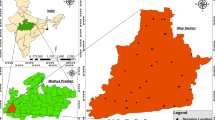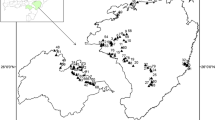Abstract
Fluoride exposure through consumption of drinking water was studied in a heavily industrialised area and suitable measures were suggested to control the fluorosis risk to residents. Groundwater quality conforms to World Health Organization (WHO) criterion for drinking except for fluoride and is also suitable for irrigation. Fluoride concentration ranges from 0.1 to 4.4 mg/l and 39% of the total samples measured were found to be contaminated as per WHO limits (1.5 mg/l). The fluoride intake through drinking water was calculated to be 0.10 mg/kg/d for infants, 0.09 mg/kg/d for children and 0.05 mg/kg/d for adults with a corresponding exposure dose exceeding 2.1, 1.9 and 1.1 times for infants, children and adults, respectively, compared to the minimum risk value of 0.05 mg/kg/d. The fluorosis risk map indicates that with a few exceptions of some western and northwestern parts, the entire study area is prone to fluorosis and the highest being in the south central part. The fluoride exposure dose suggests the risk of mottled enamel among residents if untreated groundwater is provided for drinking for a long time. Considering the hydrogeological setup of this region, various amelioration methods to help mitigate the ill effects of high fluoride were evaluated and better nutrition containing calcium and vitamin C was found to be the most effective and viable option.








Similar content being viewed by others
References
ATSDR 2003 Toxicological profile for fluorides, hydrogen fluoride, and fluorine; US Department of Health and Human Services, Public Health Service, Agency for Toxic Substances and Disease Registry, Atlanta, GA, 404p.
Batra J, Vispute J B, Deshmukh A N and Vali S 1995 Contribution from rock, soil and ground water to fluoride content of food stuffs grown in some selected villages of Bhadravati Tehsil, Chandrapur District, Maharashtra; Fluoride Environ. Nagpur, India: Gondwana Geol. Soc. 9 81–90.
Battaleb-Looie S, Moore F, Malde M K and Jacks G 2013 Fluoride in groundwater, dates and wheat: Estimated exposure dose in the population of Bushehr, Iran; Food Compos. Anal. 29(2) 94–99.
BIS 2012 Bureau of Indian Standards, drinking water specification (2nd revision) ICS 13.060.20, IS 10500:2012.
Bretzler A and Johnson C A 2015 The geogenic contamination handbook: Addressing arsenic and fluoride in drinking water; Appl. Geochem. 63 642–646.
Brindha K and Elango L 2013 Geochemistry of fluoride rich groundwater in a weathered granitic rock region, Southern India; Water Qual. Expo. Health 5(3) 127–138.
Brindha K, Jagadeshan G, Kalpana L and Elango L 2016 Fluoride in weathered rock aquifers of southern India: Managed aquifer recharge for mitigation; Environ. Sci. Pollut. Res. 23(9) 8302–8316.
Cao J, Zhao Y, Li Y, Deng H J, Yi J and Liu J W 2006 Fluoride levels in various black tea commodities: Measurement and safety evaluation; Food Chem. Toxicol. 44(7) 1131–1137.
CGWB 2010 Ground water quality in shallow aquifers of India; Central Ground Water Board, Ministry of Water Resources, Government of India, Faridabad (http://admin.indiaenvironmentportal.org.in/files/GW_Quality_in_shallow_aquifers.pdf).
Chae G T, Yun S T, Mayer B, Kim K H, Kim S Y, Kwon J S, Kim K and Koh Y K 2007 Fluorine geochemistry in bedrock groundwater of South Korea; Sci. Total Environ. 385(1) 272–283.
Chen Q, Song Z, Lu Q, Wang M, Feng J, Tian H, Liu J, Li X and Zhang R 2012 Fluorine contents and its characteristics of groundwater in fluorosis area in Laizhou Bay, China; Toxicol. Environ. Chem. 94(8) 1490–1501.
Choubisa S L and Choubisa D 2016 Status of industrial fluoride pollution and its diverse adverse health effects in man and domestic animals in India; Environ. Sci. Pollut. Res. 23(8) 7244–7254.
David M B and Gentry L E 2000 Anthropogenic inputs of nitrogen and phosphorus and riverine export for Illinois, USA; J. Environ. Qual. 29(2) 494–508.
Davies T C 2008 Environmental health impacts of East African Rift volcanism; Environ. Geochem. Health 30(4) 325–338.
Davies S N and DeWiest R J M 1966 Hydrogeology; Wiley, New York.
Dean 1993 Health effects of ingested fluoride; National Academy of Sciences, Washington, USA, 169p.
Dhadse S, Kumari P and Bhagia L J 2008 Fly ash characterization, utilization and Government initiatives in India – A review; J. Sci. Ind. Res. 67 11–18.
Dhakate R and Rao T G 2010 Assessment of groundwater quality in Talcher coalfield area, Orissa, India; Int. J. Earth Sci. Eng. 3(1) 43–55.
Durfor C N and Becker E 1964 Public water supplies of the 100 largest cities in the United States, 1962 (No. 1812); US Government Printing Office, pp. 343–346.
Eaton F M 1950 Significance of carbonates in irrigation waters; Soil Sci. 69(2) 123–134.
EU Directive C 1980 European union council directive 80/778/EEC of 15 July 1980 relating to the quality of water intended for human consumption; Off. J. Eur. Commun. L229 11–29.
Fordyce F M, Vrana K, Zhovinsky E, Povoroznuk V, Toth G, Hope B C, Iljinsky U and Baker J 2007 A health risk assessment for fluoride in Central Europe; Environ. Geochem. Health 29(2) 83–102.
Frencken J E 1992 Endemic fluorosis in developing countries: Causes, effects and possible solutions; TNO Institute for Preventive Health Care. Publ. No. 91.082, Leiden.
Genxu W and Guodong C 2001 Fluoride distribution in water and the governing factors of environment in arid north-west China; J. Arid Environ. 49(3) 601–614.
Grimaldo M, Borja-Aburto V H, Ramírez A L, Ponce M, Rosas M and Díaz-Barriga F 1995 Endemic fluorosis in San Luis Potosí, Mexico; Environ. Res. 68 25–30.
Hounslow A W 1995 Water quality data analysis and interpretation; CRC Press, Florida.
Jacks G, Bhattacharya P, Chaudhary V and Singh K P 2005 Controls on the genesis of some high-fluoride groundwaters in India; Appl. Geochem. 20(2) 221–228.
Jackson P J, Harvey P W and Young W F 2002 Chemistry and bioavailability aspects of fluoride in drinking water; Report No.: CO 5037 (http://americanfluoridationsociety.HrBorg/wp-content/uploads/2016/05/Jackson-lead-corrosive-HrBwrcreport.pdf).
Jagadeshan G, Kalpana L and Elango L 2015 Major ion signatures for identification of geochemical reactions responsible for release of fluoride from geogenic sources to groundwater and associated risk in Vaniyar River basin, Dharmapuri district, Tamil Nadu, India; Environ. Earth Sci. 74(3) 2439–2450.
Jagtap S, Yenkie M K, Labhsetwar N and Rayalu S 2012 Fluoride in drinking water and defluoridation of water; Chem. Rev. 112(4) 2454–2466.
Jha S K, Nayak A K and Sharma Y K 2009 Fluoride occurrence and assessment of exposure dose of fluoride in shallow aquifers of Makur, Unnao district, Uttar Pradesh, India; Environ. Monit. Assess. 156(1–4) 561–566.
Kalpana L and Elango L 2013 Assessment of groundwater quality for drinking and irrigation purposes in Pambar river sub-basin, Tamil Nadu; Indian J. Environ. Prot. 33(1) 1–8.
Karanth K R 1987 Groundwater assessment, development and management; Tata-McGraw-Hill, New Delhi.
Keesari T, Sinha U K, Deodhar A, Krishna S H, Ansari A, Mohokar H and Dash A 2016 High fluoride in groundwater of an industrialized area of Eastern India (Odisha): Inferences from geochemical and isotopic investigation; Environ. Earth Sci. 75(14) 1–17.
Levy S M 1994 Review of fluoride exposures and ingestion; Commun. Dent. Oral Epidemiol. 22(3) 173–180.
Lian-Fang W and Jian-Zhong H 1995 Outline of control practice of endemic fluorosis in China; Social Sci. Med. 41(8) 1191–1195.
Lloyd J W and Heathcote J A A 1985 Natural inorganic hydrochemistry in relation to ground water; Clarendon, Oxford, 294p.
Malde M K, Zerihun L, Julshamn K and Bjorvatn K 2004 Fluoride, calcium and magnesium intake in children living in a high-fluoride area in Ethiopia. Intake through food; Int. J. Paediat. Dent. 14(3) 167–174.
Malde M K, Scheidegger R, Julshamn K and Bader H P 2011 Substance flow analysis: A case study of fluoride exposure through food and beverages in young children living in Ethiopia; Environ. Health Perspect. 119(4) 579–584.
Mehta Dhaval N and Shah J 2013 Reversal of dental fluorosis: A clinical study; J. Nat. Sci. Biol. Med. 4(1) 138–144.
Moharana J K, Nanda P M and Garnaik B K 2013 Eutrofication due to industrialization in Angul-Talcher industrial complex of Odisha; Int. J. Sci. Environ. Technol. 2 20–27.
Nanda P M, Garnaik B K and Panda S 2011 Studies on Fluoride pollution in ground water of Angul-Talcher industrial complex of Odisha; Asian J. Chem. Environ. Res. 4(1) 13–16.
NEERI 2016 Integrated hydrogeological, geophysical, hydrochemical and groundwater flow and solute transport modelling studies around the ash filled South Balanda Mine voids in Angul district, Odisha (Undertaken During 2012–2016), http://environmentclearance.nic.in/writereaddata/modification/Extension/Attach_file/23112016FCAY0QHUAnnexure-HydrogeologyReport-NEERI.pdf.
NRC 1993 Health effects of ingested fluoride; National Research Council, National Academy Press, Washington DC.
Praharaj T, Tripathy S, Powell M A and Hart B R 2003 Geochemical studies to delineate topsoil contamination around an ash pond of a coal-based thermal power plant in India; Environ. Geol. 45(1) 86–97.
Ramakrishna 1998 Groundwater; Handbook, India.
Richards L A 1954 Diagnosis and improvement of saline and alkali soils; In: US Department of Agriculture, Agri. Hand book 60, Washington 78(2) 154.
Sahu B K, Panda R B, Sinha B K and Nayak A 1991 Water quality index of the River Brahmani at Rourkela industrial complex of Orissa; J. Ecotoxicol. Environ. Monit. 1(3) 169–175.
Shailaja K and Johnson M E C 2007 Fluorides in groundwater and its impact on health; J. Environ. Biol. 28 331–332.
SubbaRao N 2011 High-fluoride groundwater; Environ. Monit. Assess. 176(1) 637–645.
Rao N S, Subrahmanyam A and Rao G B 2013 Fluoride-bearing groundwater in Gummanampadu sub-basin, Guntur district, Andhra Pradesh, India; Environ. Earth Sci. 70(2) 575–586.
Tiwary R K, Dhakate R, Sinha A and Singh V S 2009 Evaluation of impact of mining on groundwater resources in Talcher Coalfield, India; Int. J. Earth Sci. Eng. 2(3) 238–252.
Todd D K 1980 Ground water hydrology; Wiley, New York.
Tripathi S D, Aravindakshan P K, Ayyappan S, Jena J K, Muduli H K, Chandra S and Pani K C I 2000 New high in crop production in India through intensive polyculture; J. Aquat. Trop. 15(2) 119–128.
Trivedy R K and Goel P K 1984 Chemical and biological methods for water pollution studies; Environmental Publication, Karad.
USSL 1954 Diagnosis and improvement of saline and alkaline soils; United States Salinity Laboratory, U.S. Department of Agriculture, Washington.
Viswanathan G, Jaswanth A and Gopalakrishnan S 2009 Mapping of fluoride endemic areas and assessment of fluoride exposure; Sci. Tot. Environ. 407(5) 1579–1587.
WHO 2002 Fluorides, environmental health criteria 227; International Programme on Chemical Safety, Geneva.
WHO 2004 Guidelines for drinking water quality (3rd edn); World Health Organization, Geneva.
WHO 2006 Guidelines for drinking-water quality (3rd edn), 1st addendum to Vol. 1, Recommendations, Geneva, 595p.
WHO 2011 Guidelines for drinking water quality; 4th edn, WHO Press, 20 Avenue Appia, Geneva, Switzerland.
Wilcox L V 1948 The quality of water for irrigation use; Vol. 962, U.S. Dept. of Agriculture, Tech, Bull, Washington, DC, 40p.
Wilcox L V 1955 Classification and use of irrigation water; Vol. 969, U.S. Geological department, Agri. Arc., Washington, DC, 19p.
Acknowledgements
The authors sincerely thank the Talcher Power Plant authorities and colleagues from Isotope Hydrology Section, BARC, for their support during sampling. Shri K S S Sarma, Head, Isotope and Radiation Application Division, BARC, is gratefully acknowledged.
Author information
Authors and Affiliations
Corresponding author
Additional information
Corresponding editor: Abhijit Mukherjee
Rights and permissions
About this article
Cite this article
Keesari, T., Sinha, U.K., Kamaraj, P. et al. Groundwater quality in a semi-arid region of India: Suitability for drinking, agriculture and fluoride exposure risk. J Earth Syst Sci 128, 24 (2019). https://doi.org/10.1007/s12040-018-1049-6
Received:
Revised:
Accepted:
Published:
DOI: https://doi.org/10.1007/s12040-018-1049-6




